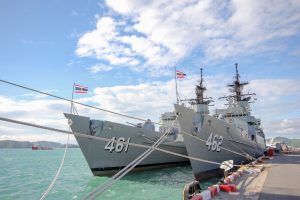As 2023 is wrapping up, it’s a fitting time to reflect on the events of the past year. One thing that stands out is the growing centrality of maritime security in international relations. The seas, notably in East Asia, are today the main arena of great power competition, pressuring smaller mainland Southeast Asian states to ramp up their naval modernization to protect their territorial, commercial, and environmental interests. Among them is Thailand, an army-dominated nation traditionally preoccupied with defense against land threats, both from abroad and within.
Throughout 2023, Thai authorities have published several documents that outline the steps necessary to enhance Thailand’s maritime governance. The 281-page National Maritime Security Plan (2023-2027), the country’s fifth iteration in the series (the first appeared in 1993) came out during the first half of the year. Accompanying this was the 5-Year Strategic Plan of the Thai Maritime Enforcement Command Center (Thai-MECC), which is Thailand’s principal maritime security authority under the prime minister’s direct supervision. Then, in October, the Royal Thai Navy (RTN) unveiled what is believed to be its first comprehensive white paper.
Yet these important publications, particularly the rare white paper, have gone quite unnoticed. It’s easy to overlook them considering that Thailand is a relatively peripheral state in maritime affairs. It has no claims in any maritime flashpoints and is unlikely to explicitly back either the United States or China in a maritime clash.
Perhaps the only aspect of Thailand’s maritime development that really turns heads is the RTN’s procurement of Chinese-made S26T submarines, and that is generally examined in the context of Bangkok’s realignment further away from its old American ally toward Beijing.
Thailand’s apparent policy flip-flop makes it harder for people to take official maritime blueprints seriously. Less than a month after the white paper was released, the government’s plan to buy an anti-submarine warfare frigate as a substitute for one S26T submarine with engine troubles – something that I interpret as a political show rather than a real deal – came into view. The issue, as noted in my last article for The Diplomat, is that the Type 054A frigate eyed by Thai officials is equipped with weapon systems that are largely incompatible with the RTN’s current arsenal. This thus overrides one of the white paper’s avowed goals: to develop a “focused force” defense posture facilitated by commonality in military equipment.
Still, it would be silly to dismiss the white paper entirely. When read alongside the other two documents, it provides some interesting insights into Thailand’s broader maritime outlook beyond weapons acquisition.
First, the Andaman Coast facing the Indian Ocean is Thailand’s strategic priority, with major infrastructure upgrades underway. The objectives are twofold: to fortify defenses against potential aggression and to facilitate economic expansion. Despite being a gateway to a crucial supply route (for oil imports, above all), Thailand’s Andaman Coast remains vulnerable without a proper shipyard. And, because of Thailand’s geographical constraints, vessels requiring repairs in the Gulf of Thailand would need to travel a long way via the Malacca Strait, which is obviously very costly, especially in times of conflict.
Economically speaking, a deep-sea port on the Andaman Sea is an integral part of the “Landbridge” project that aims to make Thailand a regional commercial and logistics hub. The Andaman is also home to Thailand’s popular beach destinations that still have room to grow. The “Andaman Wellness Corridor” scheme, as well as the booming real estate market and superyacht business in Phuket, are clear indicators. New features, such as digitally-driven smart piers and a potential cruise terminal, would effectively bolster marine tourism.
Second, Thai elites see self-reliance as imperative. Although the indigenization of the defense industry is not a new concept in Thailand, there appears to be a greater sense of urgency to translate this into reality. The white paper, which has 27 pages of content, repeatedly uses the Thai term for self-reliance (การพึ่งพาตนเอง) and contains a list of private companies capable of constructing ships domestically. Furthermore, three research projects – to develop an unmanned aerial vehicle, unmanned surface vehicle, and midget submarine – aimed at boosting self-reliance are among the RTN’s top priorities for the next 14 years. It’s safe to say that Thailand wants to portray itself to the world as a serious and able maritime player.
Third, while most regional states are consolidating their coast guards as standalone units to cope with enlarging maritime responsibilities, Thailand does not have such a plan and is relying on Thai-MECC and the RTN’s coast guard squadron (all operate on a rotational basis) for law enforcement missions. Why? Thailand’s comparatively low-threat environment is one answer, but there are other considerations. One can argue that Thai leaders see centralization as the best governance model. The Thai bureaucracy is evidently rigidly centralized and Thai-MECC, another highly centralized force that can swiftly make decisions and pool whatever resources to tackle maritime problems, is considered a critical strength in the National Maritime Security Plan.
Even if Thailand wishes to follow the trend, establishing a dedicated coast guard seems impractical due to personnel shortages. Thailand’s birthrate is alarmingly low – possibly even worse than that of South Korea. And, given the youth-led rejection of military-backed political parties and calls to abolish conscription, it makes sense to think that many youngsters view military service with contempt. The growing focus on the welfare and career trajectories of lower-ranked officers in government papers is ultimately a systematic effort to rally more public support.































